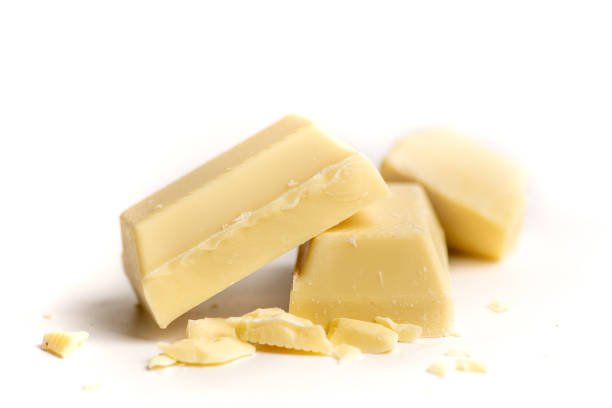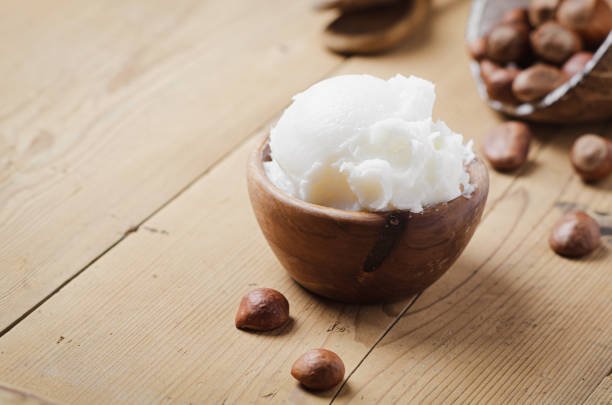Differences in benefits, texture, and skincare uses.
Cocoa butter vs Shea butter are the two most popular when it comes to natural moisturizers. Both are plant-based fats widely used in skincare for their nourishing properties, but they have some key differences in composition and effect on the skin. Cocoa butter is extracted from cocoa beans (the same source as chocolate) and is a firmer, more solid butter with a faint cocoa scentcurology.com. Shea butter comes from the nut of the African shea tree and has a softer, creamier texture with a mild, nutty aromacurology.com.
Both butters are rich in fatty acids like oleic and stearic acid, which help moisturize and protect the skincurology.com. They also share anti-inflammatory qualities and are common ingredients in lotions, balms, and body butterscurology.com. However, the way they interact with the skin can differ, making each butter more suitable for certain skin types and concerns. Let’s compare cocoa butter vs. shea butter in terms of texture, skin benefits, and ideal uses.
Table of Contents
Composition and Texture Differences
Cocoa butter is slightly harder at room temperature and typically comes in a pale yellow solid form that melts upon contact with warm skincurology.com. Unrefined cocoa butter retains a pleasant chocolate-like fragrance. It is classified as an occlusive moisturizer – when applied to skin, it creates a protective layer that locks in moisturetomsofmaine.com. Cocoa butter consists mostly of saturated fats (like stearic and palmitic acid) and is especially known for its stability (it has a long shelf life). It also contains cocoa mass polyphenols, which are antioxidants that may help protect skin from premature aging and improve elasticityhealthline.com.
Shea butter, on the other hand, is softer (almost malleable like a thick cream) and has an ivory color. It’s rich in unsaturated fats and vitamins E and A, contributing to its potent antioxidant profilehealthline.comhealthline.com. Shea butter is primarily an emollient – it soaks into the skin to fill in dry, cracked areas with lipids, helping to heal and soften skintomsofmaine.com.
It has natural anti-inflammatory compounds that can soothe redness and irritationhealthline.com. In terms of scent, raw shea butter’s smell is much milder and more neutral than cocoa butter’s chocolaty aroma, which can be an advantage for those sensitive to fragrances or who want to add their own essential oils. Visually, cocoa butter is usually a bit more yellow, while shea is off-white; this is a minor difference but can matter in formulary aesthetics.
Benefits for Skin and Best Uses
1. Cocoa Butter Benefits
Cocoa butter is well-known for its ability to form a protective barrier on the skin, making it ideal for extremely dry areas and for preventing moisture loss. Many people apply it to elbows, knees, feet, or lips since it stays on the skin’s surface, providing long-lasting hydration. The rich fats in cocoa butter help replenish the skin’s natural oils (stratum corneum lipids), which strengthens the skin’s moisture barrier. Because of these nourishing properties, it’s highly recommended for those with dry or dehydrated skin.

2. Cocoa Butter Best Uses
One of the most popular uses of cocoa butter is for reducing or preventing stretch marks. Expectant mothers often apply cocoa butter creams to the belly to keep the skin supple, though scientific evidence on its effectiveness is mixed. Its polyphenol content may also improve skin elasticity and tone over time. However, cocoa butter is considered comedogenic, meaning it can clog pores for some users. With a rating of about 4 on the 0–5 comedogenic scale, individuals with oily or acne-prone skin may find cocoa butter too heavy for facial use, as it could potentially contribute to breakouts.
3. Shea Butter Benefits
Shea butter, on the other hand, is better tolerated by a wider variety of skin types, including sensitive and acne-prone skin. It is non-irritating and less likely to clog pores compared to cocoa butter. Rich in linoleic acid—a fatty acid that the skin needs but cannot produce on its own—shea butter helps maintain the skin’s moisture barrier without feeling greasy. It also contains vitamins and antioxidants such as vitamin E, which fights free radicals, and vitamin A, which supports collagen production and skin repair. These nutrients help soothe inflammation, calm eczema, and improve overall skin resilience.

4. Shea Butter Best Uses
Because of its lightweight yet nourishing texture, shea butter is a preferred choice for facial moisturizers. It absorbs relatively quickly, leaving behind a smooth, satiny finish rather than a greasy residue. This makes it a common ingredient in face creams, eye creams, and even hair conditioners. By contrast, cocoa butter is more frequently used in body lotions and lip balms. Some people also blend both butters in DIY skincare formulations to achieve a balanced mix—combining cocoa butter’s rich moisture barrier with shea butter’s gentle, easily absorbed hydration.
Which Butter to Choose?
The choice between cocoa butter and shea butter ultimately depends on your skin needs:
- For very dry, cracked, or mature skin: Cocoa butter’s heavy-duty occlusive power is advantageous. It will prevent transepidermal water loss and keep skin moisturized for longer. On areas like hands (especially in winter), feet, or any rough patches, cocoa butter is excellent. It’s also great for massage balms because it melts slowly and provides good slip.
- For sensitive, inflamed, or acne-prone skin: Shea butter is usually the better choice. Its anti-inflammatory properties help soothe irritation (for example, shea can calm sunburn or rash redness)healthline.com. And since it’s unlikely to block pores, it moisturizes without causing breakouts in those prone to acnecurology.com. Shea’s lighter, creamier texture also makes it easier to spread on larger areas like the face.
- For anti-aging or scar treatment: Both butters have merits. Cocoa butter’s antioxidants and protective layer can support skin elasticity (hence its use for stretch marks)healthline.com. Shea butter’s vitamins can aid in skin repair and reducing scar appearance over time. In fact, shea butter is renowned in African communities as a remedy for scars and minor wounds. You might even use both: apply shea butter first to let it absorb and heal, then cocoa butter on top to seal everything in.
In summary, cocoa butter vs. shea butter isn’t a battle where one is strictly better than the other – they each shine in different scenarios. Cocoa butter offers intense, long-lasting moisture and barrier protection, while shea butter offers deep nourishment with a lighter feel and fewer pore issues. Many people keep both on hand or choose products that contain a blend of both, thereby enjoying the best of both worlds.
FAQ
Q: Can I use cocoa butter or shea butter on my face?
A: Shea butter is generally safe for the face and is unlikely to cause breakouts for most people. It’s frequently used in facial moisturizers, even for oily or combination skin, because it hydrates without clogging porescurology.com. Cocoa butter, however, is very rich and comedogenic – if you have oily or acne-prone skin, pure cocoa butter on the face might lead to pimples or blackheadscurology.com.
Some people with very dry or mature skin do use cocoa butter on the face (it can help with dryness and fine lines), but it’s best to use it sparingly or in areas prone to dryness. If you want to try cocoa butter on your face, consider a formulation where it’s blended with non-comedogenic oils to balance it out, and always do a patch test. Shea butter is the safer bet for facial care in most cases.
Q: Which is better for treating scars or stretch marks – cocoa butter or shea butter?
A: Both have reputations for helping improve the appearance of scars and stretch marks, largely by keeping the skin moisturized and supple. Cocoa butter has long been touted for stretch mark prevention during pregnancy – its occlusive action keeps skin elastic as it stretches. While evidence is anecdotal, many find regular cocoa butter application keeps their skin softer and perhaps less prone to severe stretch marks (though genetics also play a big role).
Shea butter, rich in vitamins A and E, can support skin regeneration and may help scars fade over time by softening the scar tissue and reducing inflammation. In practice, you can’t go wrong with either: massage the butter into the scar or stretch mark daily. Some products even combine cocoa and shea with other ingredients (like vitamin E or rosehip oil) for a multi-pronged approach. The key is consistent, long-term use – over weeks and months – to see improvement.
Q: Do cocoa butter and shea butter expire or go bad?
A: Both cocoa butter and shea butter are quite stable natural fats, especially if unrefined. Cocoa butter, in particular, has a shelf life of 2–5 years because of its high saturated fat content and antioxidants (it resists oxidation). Shea butter can last about 1–2 years, especially if stored properly (cool, dark place in an airtight container). Over time, they may lose some potency or develop a slight change in smell.
If your cocoa butter or shea butter develops a rancid or off odor, or the texture dramatically changes (e.g. grainy Shea can happen if it’s been melted and re-hardened incorrectly), it may be past its prime. To maximize shelf life, avoid contaminating them with water or fingers – use clean utensils to scoop – and store away from heat. Adding a few drops of vitamin E oil can also extend shelf life as a natural preservative. Generally, though, both butters are used up long before they would spoil!



